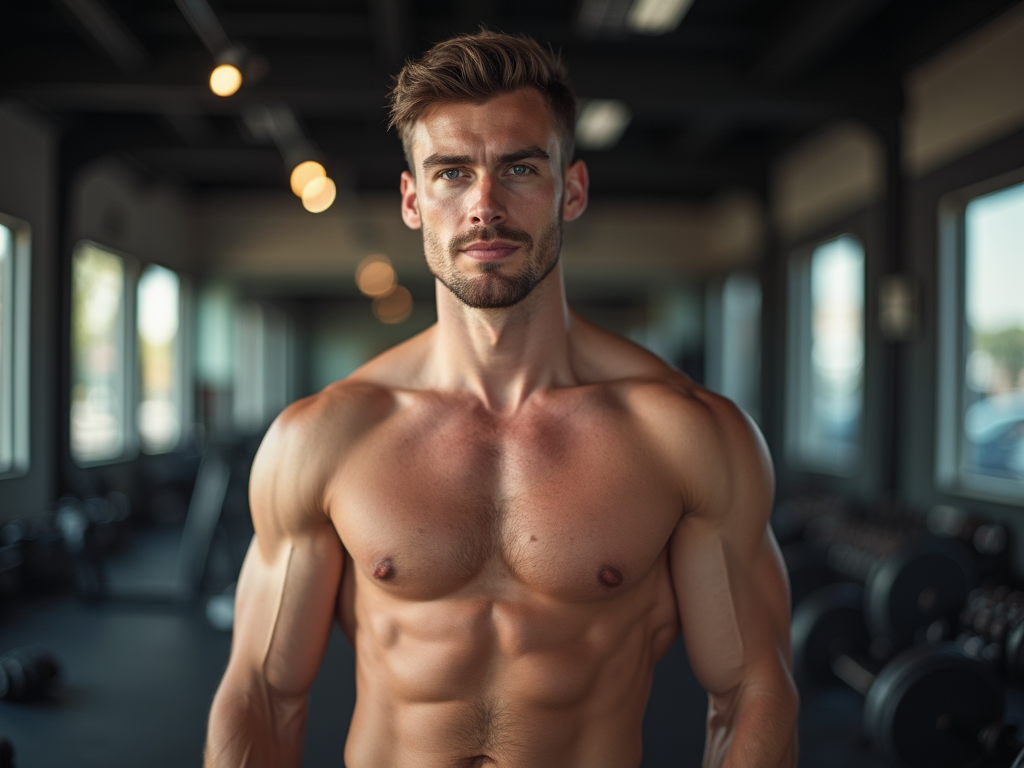Have you ever wondered what bicep size is considered big? Sure, arms for the most part are the first muscle group people starting out in the gym obsess over... In this article, we will go over in depth how big your arms should be and what you should really consider as a good achievement.
Bicep Size Calculator: Are Your Biceps Considered Big?
This calculator helps you determine if your biceps are considered "big" based on your height, weight, and bicep circumference. It uses a combination of absolute size and proportional metrics to give you a comprehensive assessment.
| Gender | Small | Average | Above Average | Big | Massive |
|---|---|---|---|---|---|
| Men | <13" | 13-14" | 14-16" | 16-18" | >18" |
| Women | <11" | 11-12" | 12-13" | 13-14" | >14" |
Understanding Bicep Size
What's considered a "big" bicep can vary based on several factors:
- Absolute Size: Generally, for men, biceps over 16 inches are considered very large. For women, over 13 inches is considered very large.
- Proportional Size: Your bicep size should be compared to your overall body size. A common metric is that your flexed bicep should measure more than your neck circumference.
- Body Fat Percentage: Lower body fat can make biceps appear larger and more defined.
- Genetics: Factors like muscle insertion points and natural muscle belly size can affect bicep appearance.
Remember, "big" is subjective and can vary based on personal goals and aesthetics. Focus on personal progress and overall body proportion rather than arbitrary numbers.
Understanding the Muscles that Make the Arms
Arms are divided into two parts, anatomically speaking. We don’t blame you for thinking that it was only the bicep. It is probably the most popular muscle amongst fitness buffs universally. One that has its own emoji.
But your arms are made up of the upper arm and the forearm. The upper arm comprises of the anterior compartment and the posterior compartment and runs from your shoulders to your elbow.
The part below the elbow is the forearm which is also made up of anterior and posterior compartments. Each compartment has multiple muscles. In this article, we are going to focus solely on the upper arm, which is made up of the Bicep and the Triceps.
Video showing you how to correctly measure bicep size
The Bicep – Functions & Aesthetics
Picture this. You are walking out of the gym with the best pump you’ve had all week. Someone asks you to flex your muscles. Chances are that you are going to instinctively give them a glorious ‘Front Double Bicep’.
That’s because the Bicep or the ‘Biceps brachii’ is the de facto show muscle. But beyond popping out of your t-shirt, it performs some very important functions.
It allows you to flex your elbow and supinate the forearm, two physiologically-critical functional movements. Flexion is when you move your wrist towards your shoulder, like the bicep curl. Supination and pronation is when you move your arm inwards towards your waist and outwards again.
In addition to this, it also helps the shoulders to flex the humerus, especially while moving it anteriorly.

The Biceps is made up of two heads, the long head and the short head. The short head of the bicep is located on the ‘inside’ of the arm, while the long head is located more laterally. When you flex your bicep, the short head or the medially located part will determine the thickness, while the long head will determine the bicep height, commonly called ‘The Peak’.
There is also the Bicep brachialis which lies hidden under the long head and is very underrated for what it can do aesthetically. It ‘pushes’ the long head of the bicep upwards making it appear taller, or giving you the famed bicep peak.
This does depend to an extent on your genetic bicep insertions. Some people are born with longer bicep bellies which make their biceps appear thicker, but shorter. A case in point is bodybuilder Sergio Olivia. Others are gifted with shorter bicep bellies, which makes their peak appear much taller. A prime example would be Arnie Schwarzenegger.
To increase the size of your biceps, you have to focus on both the bicep heads and the brachialis. We will touch on this when we cover exercises to increase bicep size.
The Triceps – Functionality & Aesthetics
The Triceps make up 66% of the arm. That’s 2/3rd of the arm size. So, if you are guilty of hyper-focusing on the biceps, you know why your arms are scrawny to begin with.
The Triceps is associated with some of the most important functional movements. At the forefront is extension of the elbow joint, for which it works in synergy with the biceps. At the shoulder joint, the triceps and the lateral muscles work together to help you move your arm towards your body.
Come workout time, the triceps are an important secondary muscle involved in all your push exercises. That includes the chest press, the shoulder press, and power moves like the clean and jerk.
Aesthetically, it is very important to build thick triceps if you are looking to increase arm size. The Triceps are made up of three muscle heads, which are the lateral head, the medial head, and the long head.
Just like the biceps, you have to ensure that you hit all three to add size to your arms.
The Average Arm Size for Men & Women
Before we begin to crunch numbers, let’s take a look at some average arm sizes according to one’s age and sex. These numbers may vary greatly in people who are chemically enhanced mind you. But if you are a regular joe drinking their protein shakes and creatine, then chances are that your arm size is close to this.
Female Age – Average Bicep Size
- 20-29 — 12.4"
- 30-39 — 12.9"
- 40-49 — 12.9"
- 50-59 — 12.9"
- 60-69 — 12.7"
- 70-79 — 12.6"
Men Age – Average Bicep Size
- 20-29 — 13.6"
- 30-39 — 13.8"
- 40-49 — 13.9"
- 50-59 — 13.5"
- 60-69 — 13.4"
- 70-79 — 12.9"
As you can see, the average numbers are nothing to write home about. If you are even at 14”, your arms are probably considered bigger than most of the population. But if you lift, your comparison is no longer with mere mortals, is it?
What Size Arms Should You Have?
To be honest, your arm size is considered big as long as it ‘looks big on you’ and is in symmetry with the rest of your body.
Factors That Can Affect Arm Size
Chemical Enhancement – The arms of bodybuilders from past decades, like Steeve Reeves, were smaller compared to today’s chemically-enhanced competitors. His arms were said to be 18.5". In contrast, modern-day bodybuilders, like Ronnie Coleman with his 24" arms, have bigger measurements due to the use of performance-enhancing drugs.
Fat Percentage – When we talk about arms, we mean lean muscle. Someone at 35% body fat could also boast of 20-inch arms, but once the fat is stripped away, the muscle tissue might only be 12-13 inches. Always check body composition before comparing arm sizes.
How to Increase Inches to Your Arm Size
So, you want bigger arms? To add size, you need to target every single muscle head in your upper arm. That means working your biceps and triceps, eating the right foods, and maintaining consistency. Here's how you can start seeing results.
Exercises to Achieve Bigger Arm Size
This is by no means an exhaustive list, but the good news is that there are hundreds of arm workout plans available. You’ll never run out of exercises to try. Here’s a basic routine to help you hit all the key muscle heads:
- Standing Bicep Barbell Curl – Targets the long head of the biceps. Arnold Schwarzenegger called this the ‘Granddaddy of all Arm Exercises’.
- Seated Dumbbell Curls – A great exercise for both the short and long head of the biceps, allowing for isolated contraction.
- Hammer Curls – Targets the brachialis and your forearm. Did you know that increasing your forearm size can also help you increase your overall arm size?
- Preacher Curls – Offers more isolation for the biceps by eliminating the involvement of the shoulder.
- Chin-Ups – Add weight. This is a terrific compound move that works your arms and back, particularly effective for building overall arm strength and size.
- Dips – Targets all three tricep heads, and also hits the chest and shoulders.
- Skull Crushers – Focuses on the long head and the lateral head of the triceps, providing excellent stimulation for tricep growth.
- Kickbacks – Another great tricep isolation exercise that targets the lateral head of the triceps.
This routine covers a broad range of exercises to ensure all-round arm development. While it's not exhaustive, it’s a solid starting point to build bigger arms.
Focusing on Hypertrophy for Bicep Size
Arms are a critical secondary muscle group. You work them out automatically whenever you hit any upper body muscle group. But if your arm size isn’t growing despite having the best workout schedule, it’s time to evaluate your plan.
Here are some ground rules for hypertrophy:
- Work your arms 2-3 times per week only.
- Hit at least 8-14 sets in total volume.
- 6-8 reps per set is the sweet spot for most lifters. You can go to 12 reps if needed. Some bodybuilders recommend going beyond failure, but that’s goal-specific.
- Rest for 90 seconds between sets. This doesn’t apply for supersets, but try not to spend more than 3 minutes chatting or staring in the mirror between sets.
- Aim for 85% of your 1RM (one-rep max).
- Ensure you have at least 48 hours of rest between upper body workouts.
Do You Need a Separate Arm Day for Bigger Arms?
This depends on your goals. It won’t hurt to have a separate arm training day, especially if you’re struggling to add size. Some people add a couple of arm exercises at the end of their major muscle group workouts. For instance, if you're working chest, add two sets of triceps exercises towards the end. If you're working back, add some bicep curls.
But keep in mind that you might not be able to go full steam, as your arms will already be fatigued from heavy lifting. A separate arm day allows you to train them fresh and add isolation moves, which will allow you to focus on form and concentration.
If you're training your upper body three times a week, make one of these days an arms-focused day. That way, you’ll get two days of indirect arm work and one day of direct arm training.
Measuring Your Arm Size the Right Way
Last but not least, let’s talk about how to measure your arms properly.
- Measure your arms cold, with no pump, and at least 12 hours since your last workout.
- Flex your biceps.
- Grab a dry measuring tape and wrap it around the thickest part of your arm, which is generally around the center, between the elbow and the shoulder.
- The tape must be snug but not tight enough to dig into your skin.
- Ensure the tape is straight, not bent.
If done right, this number is your upper arm size.
Wrapping Up
So, after reading this post, are you still wondering what bicep size is considered big? Rather than focusing solely on arm size, symmetry might be a better goal to aim for. Sure, if your arms are your weak spot, you can pay more attention by targeting all muscle heads in a separate workout.
But compared to the rest of the muscle groups, your arms are relatively small. Follow the basics, work hard, and you’ll see the results you’re after.
FAQ: Your Questions About Arm Size Answered
Are 14-inch arms big?
For the average person, yes, 14-inch arms are bigger than most of the population, especially if you’re lean. But in the lifting world, that’s just the starting point. If you’ve been training for a while, you’ll probably want to aim for 15-16 inches to stand out. Keep those reps going, and you'll be there in no time.
What are considered big arms?
Big arms generally start around 15-16 inches for most people. But, here’s the kicker – it’s all about how it looks on you. If you're 5'6", 15-inch arms might look massive, but if you’re a 6'4" giant, it might take 17 inches or more to get that “big” look. Size matters, but so does symmetry.
Are 16-inch arms big?
Absolutely! For most gym-goers, 16-inch arms are a solid achievement. They’re big enough to get noticed, but still within the range of natural, lean muscle size. If you’re hitting 16 inches with low body fat, you’re definitely in the “big arms” club. Flex those guns with pride!
How do you measure your biceps?
Measuring your biceps is a piece of cake. Flex your biceps (you know you want to) and wrap a tape measure around the thickest part of your upper arm – usually midway between your shoulder and elbow. Make sure the tape isn’t too tight or too loose – we’re measuring muscle, not circulation!
What's the average arm size for men and women?
For men, the average is around 13-14 inches, while for women it’s closer to 12-13 inches. But if you’re lifting, you’re not aiming for “average,” are you? With consistent training, you can easily surpass these numbers and stand out in the gym.
Are 15-inch arms big?
For most people, yes! 15-inch arms are well above average, and they’re definitely impressive. You’re on the path to greatness. With some targeted training, you could push through to 17-18 inches and join the ranks of the “rare immortals.”
How can I grow my arms bigger?
Here’s the secret: Don’t just train biceps. The triceps make up two-thirds of your upper arm, so if you want to grow your arms, hit the triceps hard too. Focus on compound lifts like chin-ups and dips, and don’t forget isolation exercises like barbell curls and skull crushers. Nutrition and recovery are just as important, so eat big, sleep well, and watch those arms grow!
About the Author
Jeff Warner is a gym enthusiast with more than 20 years of experience. He began his fitness journey in his late teens, and over the years, he’s become a trusted resource on fitness, nutrition, and muscle building. His passion for fitness and real-life experiences shine through in every article he writes.














